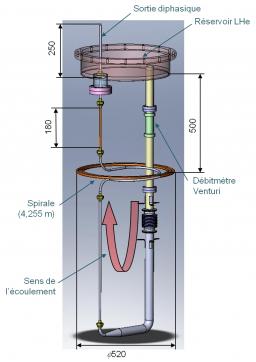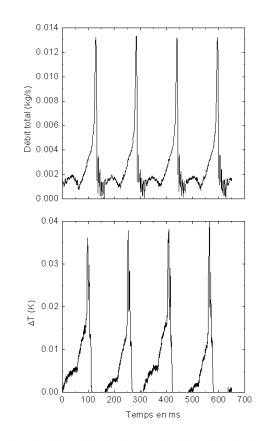
Diagram of the Thermosiphon loop in a horizontal configuration. The length of the test tube is around 4 m in order to represent the length of the cooling tubes in the R3B-GLAD magnet. It has therefore been installed in a coil.
Many of the cooling systems used for superconducting magnets in high energy physics applications are based on two-phase helium convection circulation loops. Experimental and theoretical steady state studies have already been carried out at SACM, focusing on the transfers of mass and heat in this type of vertically oriented flow as part of the design work to dimension the cooling system for the magnet in the CMS detector installed at CERN. The same operating principle has been chosen for cooling the magnet of the R3B-GLAB spectrometer being built for GSI in Germany.
In this case, the orientation of the cooling tubes is horizontal. The Thermosiphon experimental facility has been adapted for use in this configuration. The horizontal orientation gives rise to oscillations and instabilities in the flow at low heat fluxes. These oscillations are caused by a geysering effect which occurs when the vaporization of helium in the cooling tube generates a periodic imbalance in the masses in each of the two branches of the loop. However, the impact on the cooling remains negligible as the variations in temperature are less than a few tens of millikelvin. At low heat fluxes, nucleate boiling dominates the heat transfer, and measurements have confirmed the cooling design to be used in the R3B-GLAB magnet. At higher heat fluxes, the properties return to those of a normal two-phase horizontal flow.
Other research into vertical natural convection circulation loops used at higher temperatures is also being carried out which could be applied to the cooling of high critical temperature superconducting magnets. Measurements on nitrogen have shown that, at low heat fluxes, the flow is single phase and a mixed convection regime is established, combining both natural and forced convection. Nucleate boiling occurs at heat fluxes above a critical value. Nitrogen circulation loops have a high cooling capacity as it is possible to extract several kW/m2 with increases in wall temperature of just a few K at 77 K.


